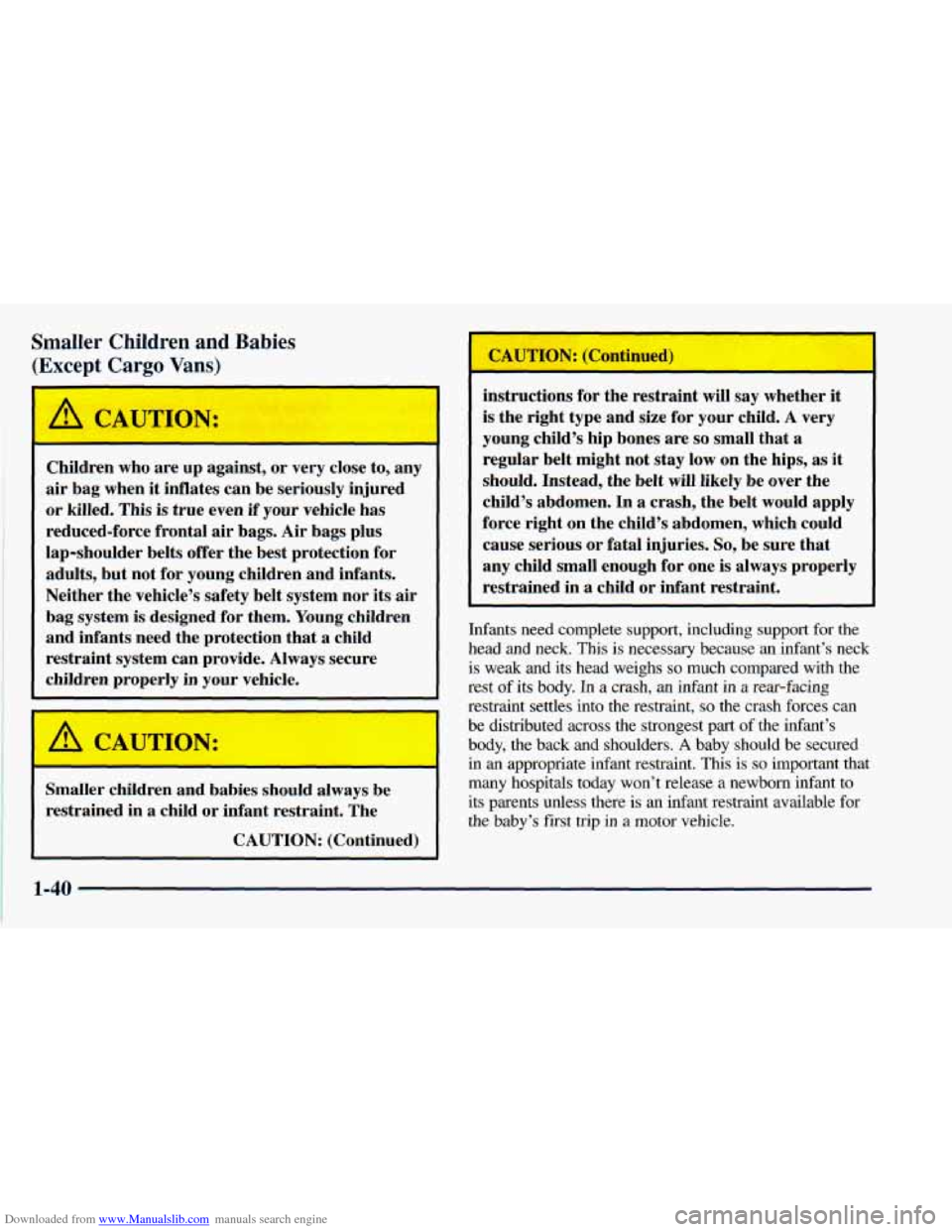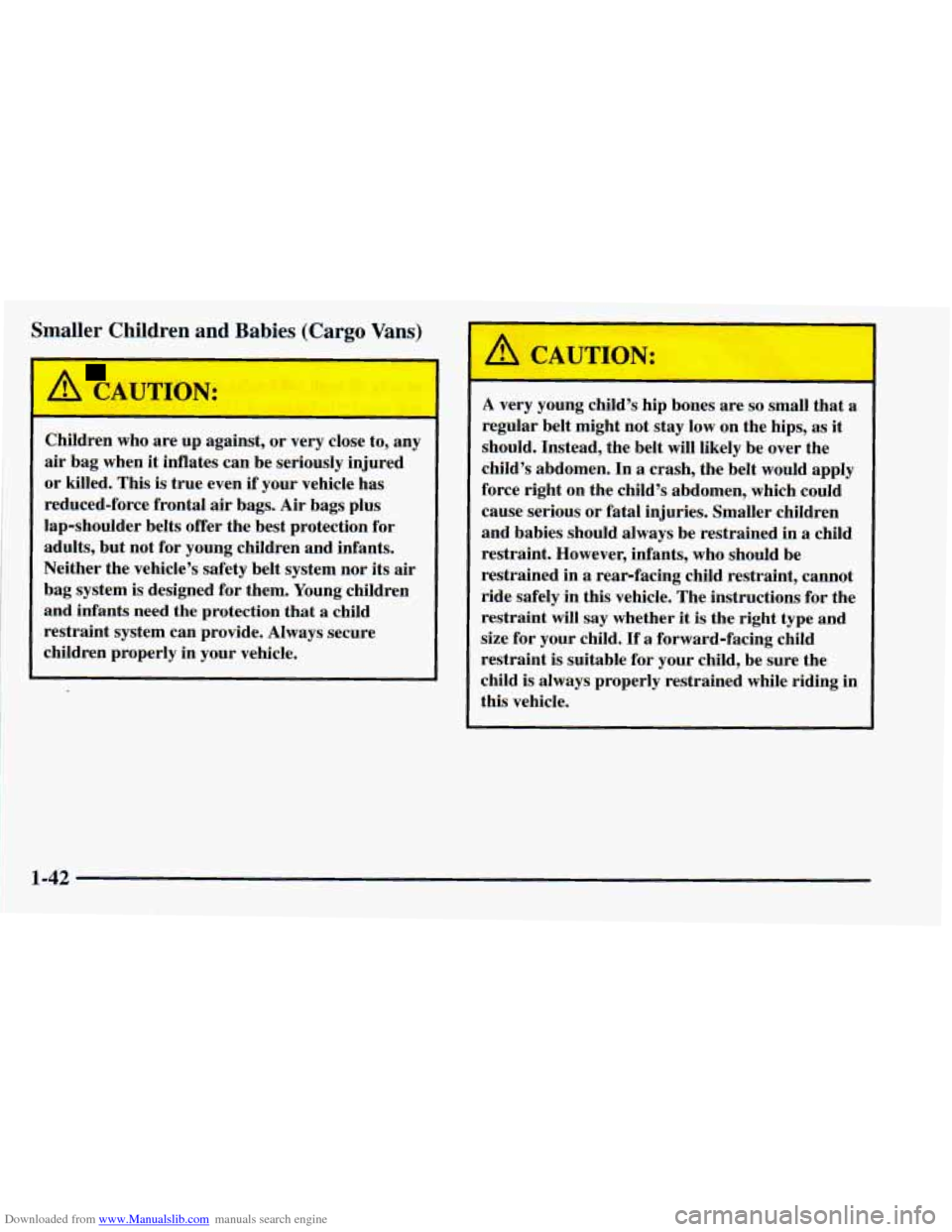Page 32 of 414

Downloaded from www.Manualslib.com manuals search engine How to Wear Safety Belts Properly
Adults
This part is only for people of adult size.
Be aware that there are special things to know about
safety belts and children. And there are different rules
for smaller children and babies. If
a child will be
riding in your vehicle, see the part of this manual
called “Children.” Follow those rules for everyone’s
protection.
First, you’ll want
to know which restraint systems
your vehicle has.
We’ll start with the driver position.
Driver Position
This part describes the driver’s restraint system.
Lap-Shoulder Belt
The driver has a lap-shoulder belt. Here’s how to wear
it properly.
1. Close and lock the door.
2. Adjust the seat (to see how, see “Seats” in the Index)
so you can sit up straight.
3. Pick up the latch plate and pull the belt across you.
4. Push the latch plate into the buckle until it clicks.
Don’t
let it get twisted.
Pull up
on the latch plate to make sure it is secure.
If the belt isn’t long enough, see “Safety Belt
Extender” at the end
of this section.
Make sure the release button
on the buckle is
positioned
so you would be able to unbuckle the
safety belt quickly if you ever had to.
1-18
Page 41 of 414

Downloaded from www.Manualslib.com manuals search engine i
I
1 CAUTION:
Air bags inflate with great force, faster than the
blink of an eye. If you’re too close to an inflating
air bag, it could seriously injure you. Safety belts
help keep you in position before and during a
crash. Always wear your safety belt, even with
air
bags. The driver should sit as far back as possible
while still maintaining control of the vehicle.
c
i
A CAUTION:
Children who are up against, or very close to, an
air bag when
it inflates can be seriously injured
or killed. This is true even if your vehicle has
reduced-force frontal
air bags. Air bags plus
lap-shoulder belts offer the best protection for
adults, but not for young children and infants.
Neither the vehicle’s safety belt system nor its air
CAUTION: (Continued)
I CAUTION: (Continued)
bag system is designed for them. Young children
and infants need the protection that
a child
restraint system can provide. Always secure
children properly in your vehicle.
To read how,
see the part of this manual called “Children” and
see the caution labels on the sunvisors and the
right front passenger’s safety belt.
There is an air bag
readiness light on the
instrument panel, which
BAG
shows AIRBAG.
The system checks the air bag electrical system for
malfunctions. The light tells you
if there is an electrical
problem. See “Air Bag Readiness Light” in the Index
for more information.
1-27
Page 47 of 414
Downloaded from www.Manualslib.com manuals search engine I‘ Lap-Shoulder Belt
These positions have lap-shoulder belts. Here’s how to
wear one properly.
1. Pick up the latch plate and pull the belt across you.
Don’t let it get twisted.
2. Push the latch plate into the buckle until it clicks. If
the belt stops before it reaches the buckle, tilt the
latch plate and keep pulling until you can buckle it.
Pull up on the latch plate to make sure it is secure.
If the belt is not long enough, see “Safety Belt
Extender” at the end
of this section.
Make sure the release button on the buckle is
positioned
so you would be able to unbuckle the
safety belt quickly if you ever had to.
1-33
Page 54 of 414

Downloaded from www.Manualslib.com manuals search engine Smaller Children and Babies
(Except Cargo Vans)
A CAUTION:
Children who are up against, or very close to, any
air bag when it inflates can be seriously injured
or killed. This is true even if your vehicle has
reduced-force frontal
air bags. Air bags plus
lap-shoulder belts offer the best protection for adults, but not for young children and infants.
Neither the vehicle’s safety belt system nor its air
bag system
is designed for them. Young children
and infants need the protection that a child
restraint system can provide. Always secure
children properly in your vehicle.
--
Smaller children and baL-3 should always be
restrained in a child or infant restraint. The
CAUTION: (Continued)
1
CAUTION: (Continued)
instructions
for the restraint will say whether it
is the right type and size for your child.
A very
young child’s hip bones are
so small that a
regular belt might not stay low on the hips, as it
should. Instead, the belt will likely be over the
child’s abdomen. In
a crash, the belt would apply
force right on the child’s abdomen, which could
cause serious or fatal injuries.
So, be sure that
any child small enough for one is always properly
restrained in a child or infant restraint.
Infants need complete support, including support for the
head and neck. This
is necessary because an infant’s neck
is weak and its head weighs
so much compared with the
rest of
its body. In a crash, an infant in a rear-facing
restraint settles into the restraint,
so the crash forces can
be distributed across the strongest part of the infant’s
body, the back and shoulders.
A baby should be secured
in
an appropriate infant restraint. This is so important that
many hospitals today won’t release a newborn infant
to
its parents unless there is an infant restraint available for
the baby’s first trip in
a motor vehicle.
1-40
Page 55 of 414
Downloaded from www.Manualslib.com manuals search engine 1 A CAUTION:
Never hold a baby in your arms while riding in a
vehicle.
A baby doesn’t weigh much -- until a
crash. During
a crash a baby will become so
heavy you can’t hold it. For example, in a crash
CAUTION: (Continued) CAUTION: (Continued)
at only
25 mph (40 km/h), a 12-1b. (5.5 kg) baby
will suddenly become a 240-1b.
(110 kg) force on
your arms. The baby would be almost impossible
to hold.
Secure the baby in an infant restraint.
1-41
Page 56 of 414

Downloaded from www.Manualslib.com manuals search engine Smaller Children and Babies (Cargo Vans)
Children who are up against, or very close to, any
air bag when it inflates can be seriously injured
or killed. This is true even
if your vehicle has
reduced-force frontal air bags. Air bags plus
lap-shoulder belts offer the best protection for
adults, but not for young children and infants.
Neither the vehicle’s safety belt system nor its air
bag system is designed for them. Young children
and infants need the protection that a child
restraint system can provide. Always secure
children properly in your vehicle.
--
I A CAUTION:
A very young child’s hip bones are so small that a
regular belt might not stay low on the hips,
as it
should. Instead, the belt will likely be over the
child’s abdomen. In a crash, the belt would apply
force right on the child’s abdomen, which could
cause serious or fatal injuries. Smaller children
and babies should always be restrained in a child
restraint. However, infants, who should be
restrained in a rear-facing child restraint, cannot
ride safely in this vehicle. The instructions for the
restraint will say whether
it is the right type and
size for your child.
If a forward-facing child
restraint is suitable for your child, be sure the
child is always properly restrained while riding in
this vehicle.
Page 59 of 414
Downloaded from www.Manualslib.com manuals search engine BEFORE YOU USE THIS CHILD RESTRAINT,
BE SURE THE TOP OF THE CHILD’S
SHOULDERS IS BELOW THE SLOTS THAT
THE HARNESS GOES THROUGH. IF
A
CHILD WHOSE SHOULDERS ARE ABOVE
THOSE SLOTS USES THIS CHILD
RESTRAINT, THE CHILD COULD BE
IN JURED DURING A SUDDEN STOP OR
CRASH. IF THE TOP OF THE CHILD’S
SHOULDERS IS ABOVE THE SLOTS, DON’T
USE THIS CHILD RESTRAINT WHILE THE
VEHICLE IS
IN MOTION.
Securing a Child in the Built-in
Child Restraint
1. Lower the child restraint cushion.
1-45
Page 60 of 414
Downloaded from www.Manualslib.com manuals search engine You’ll be using the child restraint’s hg-ness (A)
to secure your child. Don’t use the vehicle’s
safety belts.
I
Using the vehicle’s regular safety belts on a child
seated on the child restraint cushion can cause
serious injury to the child in a sudden stop or
crash.
If a child is the proper size for the built-in
child restraint, secure the child using the child restraint’s harness, But children who are too
large for the built-in child restraint should
sit on
the vehicle’s regular seat and use the regular
safety belts.
WARNING! FAILURE TO FOLLOW THE
MANUFACTURER’S INSTRUCTIONS ON THE
USE
OF THIS CHILD RESTRAINT SYSTEM
CAN RESULT IN YOUR CHILD STRIKING THE
VEHICLE’S INTERIOR DURING A SUDDEN
BELTS PROVIDED WITH THIS CHILD
RESTRAINT AROUND YOUR CHILD.
STOP
OR CRASH. SNUGLY ADJUST THE
1-46